- Grade Levels
- English Standards
- Math Standards
- State Standards
- Kindergarten
- First Grade
- Second Grade
- Third Grade
- Fourth Grade
- Fifth Grade
- Assessment Workbooks
- Workbook Downloads
- Workbooks on USB
- Paperback Workbooks
- Student Editions
- Purchase Orders

Fourth Grade Writing Standards
Fourth Grade Standards, Fourth Grade Reading Standards, Fourth Grade Writing Standards, Fourth Grade Writing, Fourth Grade Skills, Writing Standards Fourth Grade
Fourth Grade Writing Standards
Text Types and Purposes
- Introduce a topic or text clearly, state an opinion, and create an organizational structure in which related ideas are grouped to support the writer’s purpose.
- Provide reasons that are supported by facts and details.
- Link opinion and reasons using words and phrases (e.g., for instance, in order to, in addition).
- Provide a concluding statement or section related to the opinion presented.
- Introduce a topic clearly and group related information in paragraphs and sections; include formatting (e.g., headings), illustrations, and multimedia when useful to aiding comprehension.
- Develop the topic with facts, definitions, concrete details, quotations, or other information and examples related to the topic.
- Link ideas within categories of information using words and phrases (e.g., another, for example, also, because).
- Use precise language and domain-specific vocabulary to inform about or explain the topic.
- Provide a concluding statement or section related to the information or explanation presented.
- Orient the reader by establishing a situation and introducing a narrator and/or characters; organize an event sequence that unfolds naturally.
- Use dialogue and description to develop experiences and events or show the responses of characters to situations.
- Use a variety of transitional words and phrases to manage the sequence of events.
- Use concrete words and phrases and sensory details to convey experiences and events precisely.
- Provide a conclusion that follows from the narrated experiences or events.
Production and Distribution of Writing
- W.4.4 . Produce clear and coherent writing in which the development and organization are appropriate to task, purpose, and audience. (Grade-specific expectations for writing types are defined in standards 1–3 above.)
- W.4.5 . With guidance and support from peers and adults, develop and strengthen writing as needed by planning, revising, and editing.
- W.4.6 . With some guidance and support from adults, use technology, including the Internet, to produce and publish writing as well as to interact and collaborate with others; demonstrate sufficient command of keyboarding skills to type a minimum of one page in a single sitting.
Research to Build and Present Knowledge
- W.4.7 . Conduct short research projects that build knowledge through investigation of different aspects of a topic.
- W.4.8 . Recall relevant information from experiences or gather relevant information from print and digital sources; take notes and categorize information, and provide a list of sources.
- Apply grade 4 Reading standards to literature (e.g., “Describe in depth a character, setting, or event in a story or drama, drawing on specific details in the text [e.g., a character’s thoughts, words, or actions].”).
- Apply grade 4 Reading standards to informational texts (e.g., “Explain how an author uses reasons and evidence to support particular points in a text”).
Range of Writing
- W.4.10 . Write routinely over extended time frames (time for research, reflection, and revision) and shorter time frames (a single sitting or a day or two) for a range of discipline-specific tasks, purposes, and audiences.
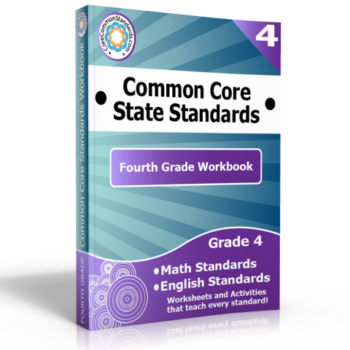
Fourth Grade Common Core Workbook Download
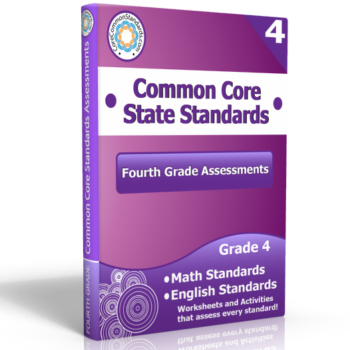
Fourth Grade Common Core Assessment Workbook Download
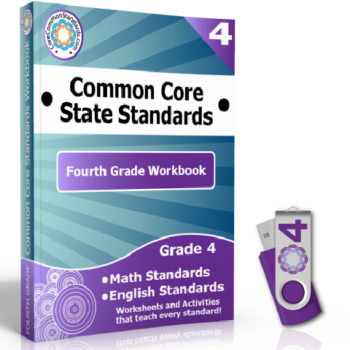
Fourth Grade Common Core Workbook USB
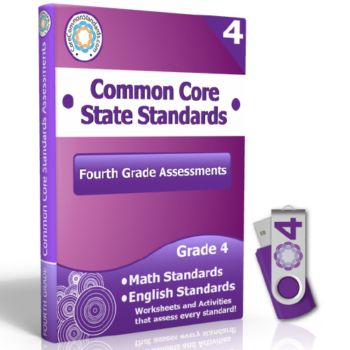
Fourth Grade Common Core Assessment Workbook USB
Fourth grade common core workbook paperback, fourth grade common core assessment workbook paperback.

Fourth Grade Common Core Standards Posters
- Book Lists by Age
- Book Lists by Category
- Reading Resources
- Language & Speech
- Raise a Reader Blog
- Back to School
- Success Guides by Grade
- Homework Help
- Social & Emotional Learning
- Activities for Kids
The Guide to 4th Grade: Reading and Writing
Review reading and writing curricula for 4th grade, including what to expect and resources to support learning..
Congratulations: Your child is officially a member of the “upper” grades! As fourth graders, students deepen their skills to prepare for middle school. That being said, they still learn like elementary school students do. Most fourth graders are developmentally very much still children — they enjoy and learn from play, and they thrive in nurturing and warm environments. However, the content of most 4th grade curricula pushes students to think, analyze, and learn in more sophisticated and structured ways than they did in the “lower” grades.
In 4th grade, students learn how to deeply think about and make connections in new material, and grasp more complex concepts across all subjects. They also write with clarity, flow, and structure similar to that of traditional essays. Fourth graders are encouraged to be more independent in how they learn, and depend less on their teacher's guidance. They research, plan, and revise their work more by themselves — setting the foundation to be lifelong, self-starting learners.
Read on for what to expect this year, and shop all books and resources for 4th grade at The Scholastic Store .
For more book and reading ideas, sign up for our Scholastic Parents newsletter!
Reading in 4th Grade
Much of the 4th grade reading curriculum teaches students how to analyze the books they read. Rather than just understand the plot and information given in a text, students are encouraged to think about the messages and how they relate to their own lives. They also compare texts to each other and make connections both within one text and across multiple texts.
In short, 4th graders begin to learn how to think and talk about a text to find deeper meanings and messages. This is done both with texts students read independently and those read by the whole class or smaller groups of students. Teachers may often use a class read-aloud to show students strategies for thinking about and analyzing what they read, encouraging them to do this in their own reading. Students also do this as they write in more detail about the texts they read.
To build reading skills, your 4th grader :
- Uses specific examples from the text to explain characters’ motivations, main events, central themes, or ideas about a text.
- Uses the context of a text to determine the meaning of a word.
- Understands and can explain the differences between narrative prose, drama, and poetry.
- Identifies and refers to the different parts of poems and plays, such as verses, settings, and characters.
- Interprets and connects information from illustrations, graphs, charts, or other sources related to the text.
- Identifies, compares, and contrasts different perspectives from which texts are written (for example, first and third person).
- Compares and contrasts the way different texts address the same issue, theme, or topic.
- Makes connections between people, events, or important ideas in a text.
- Uses previous knowledge to read unfamiliar multi-syllable words.
- Reads grade-level texts with accurate comprehension, pacing, and expression.
Fourth Grade Reading Activities
Read and Research Together : Read the same book as your child independently, together, or a combination of both. Talk about the book as you read it, reviewing main ideas and plots and expressing your opinions. Then read an additional book or books on the same subject and compare and contrast how they dealt with the same issue.
Compare Perspectives : Read two texts — one written in first person and one in third person — about the same event. Talk with your child about the differences and why they thinks these differences exist. Or, try it yourself! After sharing an experience with your child, each of you can write about it from your own perspective. Talk about the differences between what you wrote to gain a better understanding of perspective.
Read magazine and newspaper articles. Focus on the illustrations, graphs, or charts. Point out to your child what they show, ask them to help you interpret them, and discuss how they help explain or elaborate on the text.
Writing in 4th Grade
Much of the 4th grade writing curriculum focuses on developing writing that has clarity and structure, and that uses reasons, facts, and details to support and strengthen arguments. Fourth graders are taught to organize their writing, ensure that it flows well, and group together related components. As students learn to think more deeply about concepts they are taught, they are encouraged to write in deeper ways as well. They do this by going beyond simply stating the facts — they express ideas, make connections, and provide details and emotions when appropriate.
To build writing skills, your 4th grader :
- Writes opinion pieces that express a point of view; have an introduction, a conclusion, reasons, and facts to support the opinion; and group together related ideas.
- Writes informative/explanatory pieces that present information on a topic, use facts and details, and group together related topics; provides introductions and conclusions in these pieces.
- Writes narrative pieces that use specific details, descriptions, and dialogue to convey a real event; includes an introduction and conclusion in each piece.
- Plans, revises, and edits their writing.
- Uses technology to publish, research, and communicate with others under the proper guidance of an adult or teacher.
- Types with a beginner’s accuracy and ability (for example, types one page of text within one sitting).
- Completes research projects by taking notes, organizing them, and presenting them; lists the texts and resources used.
- Writes for both long (over weeks) and shorter (one sitting or a couple of days) periods of time.
Fourth Grade Writing Activities
Ask Why : When your child expresses their opinion about something, ask them why they think that or how they know it is true. This will help them learn to support their opinion with reasons and/or facts. Do the same when you express your opinion or ideas about something.
Email with your Child : Set up an email account for your child and write emails describing your days to each other. Include details, conversations, thoughts, and emotions you had. This can be done in addition to generally encouraging (and supervising) your child’s use of technology — helping them use it for research, writing, and communicating with others. As always, be cautious of your child’s technology use by monitoring and supervising how much it is used and with whom they communicate.
Practice Note Taking : When you and your child go somewhere like a museum or a new city, pretend to be reporters and take notes (give them a journal they'll love to take notes in, like the Klutz: Decorate This Journal ). Later on, use those notes to describe what you learned. You can even relay your “reports” like a newscaster would.
Shop the best resources for fourth grade below! You can find all books and activities at The Scholastic Store .
Explore other grade guides:
- Kindergarten
- First Grade
- Second Grade
- Third Grade
- Fifth Grade
- Sixth Grade
- Seventh Grade
- Eighth Grade
Your 4th Grade Book Checklist
Sign up and get 10% off books.
4th grade writing
by: Jessica Kelmon | Updated: August 4, 2022
Print article

In fourth grade, study skills play an important role in your child’s writing. Kids do research using multiple sources. They also learn to take notes on what they research, read. and hear. And even stories are more advanced, with more developed characters who show their feelings and react to what happens. And perhaps most important, your child is expected to analyze a book’s structure, logic, details, and evidence in their writing. It’s all pretty impressive!
Building 4th grade study skills
This year taking notes is an important skill. Fourth graders are expected to use books, periodicals, websites, and other digital sources to conduct research projects — both on their own and as part of group work with peers. Your child should keep track of all the sources they check — noting what they learn, the name of the source and page number or url so they can find it again and create a source list or bibliography later.
Also, taking notes while reading fiction will help your child when it comes time to analyze what they’ve read or to give an in-depth description of a character, setting, or story event drawing on specific details.
Check out this related worksheet: • Finding key points
bttr, better, best!
Last year’s prewriting step — planning — becomes more essential in your child’s writing process this year. Before your child sits down to write, they should use their organized notes to help create the structure of whatever they’re writing. While planning , your child may brainstorm ideas for a story or decide how to organize facts into a cohesive set of points. The more knowledge your child builds during the prewriting stage, the easier it will be to write. Encourage reading and rereading, taking notes, finding additional sources, discussing aloud how new knowledge fits in with what your child knew before, and visually organizing what they plan to write about. After the first draft is written, the teacher and possibly other students will offer feedback: asking questions to elicit new details or clarify an argument or suggest new sources of information. They should check that there’s a clear introduction and conclusion, and that the order of points or events makes sense. Your child will then do a revision (or two), adding, reordering, and refining their writing to show deep understanding.
After making revisions, your child does a final edit focusing on spelling, grammar, punctuation, and strengthening word choices. These steps — planning, writing a first draft, revising, and editing the final piece — help fourth graders understand that research, organizing, clarifying ideas, and improving grammar and presentation are all essential to strong writing.
See what your fourth grade writing looks like

Fourth grade writing: opinion pieces
Your child’s opinions always need to be supported by evidence. Persuasive writing should start by clearly introducing an opinion on a topic. To support their opinion, kids need to present their argument, which is a list of reasons why they hold that opinion. Each of their reasons needs to be supported by facts and details (a.k.a. evidence). After presenting all of their research-supported reasons, kids should close their arguments with a concluding statement or paragraph that sums up how their evidence supports their opinion.
Check out this example of good fourth grade opinion writing: • “ Zoos should close ”
Fourth grade writing: informative writing
This year, your child’s informative writing gets more organized, with headers, illustrations and even multimedia components to support specific points. To begin, your child should introduce the topic. Then they should use facts, definitions, details, quotes, examples, and other information to develop their topic into a few clear, well thought-out paragraphs. Your fourth grader should use advanced linking words (e.g. also, another, for example, because ) to form compound and complex sentences connecting their research and ideas to the point they’re making. Finally, to wrap it up, your child should have a conclusion — either a statement or, if necessary, a section labeled conclusion.
Check out these three examples of good fourth grade informational writing: • “ John Cabot and the Rediscovery of North America ” • “ Big Book of Evolution ” • “ Book report: A Tale of Despereaux ”
Can your fourth grader write an informational essay?

Fourth grade writing: narratives
A narrative means writing a story. This year your child will be expected to use storytelling techniques, descriptive details, and clear sequences to tell compelling tales. Whether inspired by a favorite book, real events, or your child’s imagination, your child’s story should use dialogue, descriptive words, and transitional language. Look for precise language and sensory details that bring characters to life. Finally, your child should keep pacing and sequence of events in mind. The events should unfold naturally, bringing the story to a natural conclusion. Are surprise endings okay? Sure… so long as the details and events plausibly lead there.
Check out this related worksheet: • Putting sentences in order
Gettin’ good at grammar
You may want to review all those parts of speech your child learned last year because fourth grade grammar is expected to be quite accurate. Your child should know relative pronouns (e.g. who, whose, whom, which, that ), relative adverbs (e.g. where, when, why ), adjective ordering (e.g. short dark hair and small red bag ), descriptive prepositional phrases (e.g. in the air, down the block, on the grass ), progressive past, present, and future verbs (e.g. I was walking, I am walking, I will be walking ), and verbs used with other verbs to express mood or tense (aka modal auxiliaries, e.g. can, may, must, should, would ). Also, your child needs to master the distinctions between frequently confused words like to , too , and two and there , their , and they’re . Finally, your child should be able to recognize and correct run-on sentences.
Check out these related worksheets: • Prepositions • Compound sentences • Punctuating a paragraph • Its or it’s?
Learning to use language precisely
This means:
- Recognizing and explaining common idioms (e.g. bending over backwards )
- Distinguishing between similes and metaphors (e.g. quiet as a mouse and the sun is a yellow beach ball ).
- Identifying and using synonyms and antonyms
- Using increasingly specific words in writing (e.g. glamorous instead of pretty, pre-dawn instead of morning, quizzed instead of asked )
Your fourth grader should now be using relevant academic words in informational writing and research reports. Although accurate spelling should be the norm in fourth grade, when faced with spelling more academic words, your child should use a dictionary and thesaurus (print and digital versions).
Check out these related worksheets: • 4th grade weekly spelling lists • Making metaphors • Simile or cliché?
Sharing their work
Most classrooms will encourage (if not require) kids to use technology to produce and publish their writing. Your fourth grader should be able to type up to a full page in one sitting. While teachers should be there to help, your child should be doing the work. Students will also be expected to interact with peers about each other’s work. What might that look like? Your child might read a classmates’ published work online and comment on it, or cite a peer’s work when answering a question in class.
Updated August 2022
Homes Nearby
Homes for rent and sale near schools

6 ways to improve a college essay

Quick writing tips for every age

Writing on the wall
Why parents must teach writing
Yes! Sign me up for updates relevant to my child's grade.
Please enter a valid email address
Thank you for signing up!
Server Issue: Please try again later. Sorry for the inconvenience
Reading Worksheets, Spelling, Grammar, Comprehension, Lesson Plans
4th Grade CCSS: Writing
For fourth graders, this Common Core area helps students gain mastery of writing skills by working collaboratively and producing written texts, understanding syntax and vocabulary, and organizing their ideas. Among the complete standards for this grade, fourth graders will be asked to: write opinion pieces, explanatory texts, narratives, be able to effectively write introductions, supporting details, developed ideas, reasons, and conclusions to fully realize a piece of writing, properly use illustrations, formatting, and multimedia to enhance a text, use dialogue, and descriptions of emotions and thoughts to show the response of characters to situations, use transitional words to link events in a narrative, with some adult guidance use appropriate technology to publish writing, demonstrate keyboarding skill, understand writing for specific audiences, go through the process of writing, editing and revision for their written work.
Autumn: The Scarecrow’s Surprise Writing Prompt
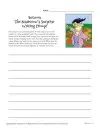
Students will further develop their creative writing skills with this Autumn writing prompt activity. This is a great worksheet to keep your students’ creativity flowing!
Classroom Reporter: Interview with a Classmate
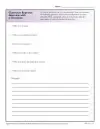
“Classroom Reporter: Interview with a Classmate” is the perfect way to introduce students to their classmates and learn more about one another.
Father’s Day Writing Prompt: He’s the Best
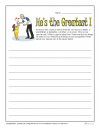
Your students will have fun writing about their father in this “He’s the Best” writing activity.
Fourth of July Writing Prompt: What Freedom Means to Me
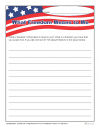
Teach your students about freedom in America with this fun Fourth of July Writing Prompt printable worksheet.
Haiku: Write Your Own!
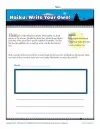
This worksheet features the Japanese poetry style haiku.
Kwanzaa Candles: Who Lights First? Writing Prompt

It’s the first night of Kwanzaa and the entire Thompson family has gathered for the celebration. It’s almost time to light the candles, and the question comes up: who should light the candles tonight? Write a story about how the Thompson family decides who will light the candles. This printable holiday writing prompt is ideal for 3rd – 5th grade, but can be used where appropriate.
Main Idea Graphic Organizer
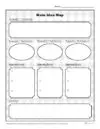
Learning how to properly structure an essay can be difficult. With this Main Idea Tree, students will create an outline that allows them to better understand the different parts of a five paragraph essay. Students will be asked to write their introduction, a main idea, three topic sentences, three supporting details for each topic sentence, and a conclusion.

Main Idea Tree
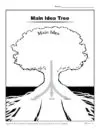
Use this image of a large tree to help your students understand the components of a paragraph. With this worksheet, students will be asked to write a main idea and follow it with three supporting details. What a great way for students to visualize the importance of the main idea in a paragraph!
My Goals for the New Year
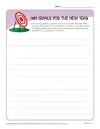
This writing prompt about New Year’s goals is a wonderful way to help your students practice their writing skills.
Native American Heritage: Create Your Totem Pole
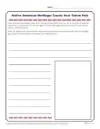
In the box on the worksheet, design your own totem pole. Make sure it represents you and your interests. Then in the writing space, describe your totem pole and explain how it illustrates you. This printable Native American Heritage Month activity is ideal for 3rd – 5th grade, but can be used where appropriate.
New Year’s Reflections

Encourage your students to look back on the events of the past year and look forward to the ones ahead with this New Years reflection worksheet.
The Lost Dreidel Writing Prompt
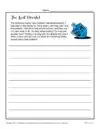
The Goldberg family has lost their Hanukkah dreidel! Write a story and tell how you think the Goldberg family should solve their problem. This printable Hanukkah writing prompt activity is perfect for keeping students engaged in class while learning about the holiday.
Using Story Elements: Plan a Story

Planning a story can be tough. This activity helps students break things down so that it’s easier to envision and write the story. A great beginning writing activity for 3rd – 5th graders.
What Happens Next? Halloween Surprise Activity
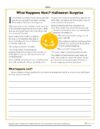
Keep learning fun during the holidays with this Halloween Reading Comprehension Activity. Students will be asked to read a passage and then answer the given questions about the story. This worksheet is great for use both at home and in the classroom.
Write a Description: Melting Snowman
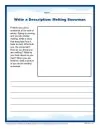
With this unique winter activity, help your students further develop their writing skills.
Write Rhyming Couplets
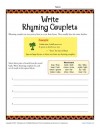
Time for some poetic rhyming couplets!
Writing Limericks

This activity lists opening lines for two limericks. Students write the other lines to complete the limerick, remembering which lines that need to rhyme.
Writing Prompt: A New Plant in Spring
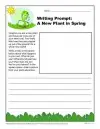
Students choose from the letters on a Spring flower and write words that start with a vowel. A fun way to practice vocabulary and anticipate the warm days to come!
Writing Prompt: She’s the Best

Students write about a special sister, grandmother, mother, or friend!
Back to School Diamante Poem
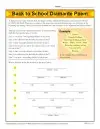
Teach your students a fun way to write diamante poems using our new back to school worksheet.
Common Core State Standards Initiative
English Language Arts Standards
The Common Core State Standards for English Language Arts & Literacy in History/Social Studies, Science, and Technical Subjects (“the standards”) represent the next generation of K–12 standards designed to prepare all students for success in college, career, and life by the time they graduate from high school.
The Common Core asks students to read stories and literature, as well as more complex texts that provide facts and background knowledge in areas such as science and social studies. Students will be challenged and asked questions that push them to refer back to what they’ve read. This stresses critical-thinking, problem-solving, and analytical skills that are required for success in college, career, and life.
The standards establish guidelines for English language arts (ELA) as well as for literacy in history/social studies, science, and technical subjects. Because students must learn to read, write, speak, listen, and use language effectively in a variety of content areas, the standards promote the literacy skills and concepts required for college and career readiness in multiple disciplines.
The College and Career Readiness Anchor Standards form the backbone of the ELA/literacy standards by articulating core knowledge and skills, while grade-specific standards provide additional specificity. Beginning in grade 6, the literacy standards allow teachers of ELA, history/social studies, science, and technical subjects to use their content area expertise to help students meet the particular challenges of reading, writing, speaking, listening, and language in their respective fields.
It is important to note that the grade 6–12 literacy standards in history/social studies, science, and technical subjects are meant to supplement content standards in those areas, not replace them. States determine how to incorporate these standards into their existing standards for those subjects or adopt them as content area literacy standards.
The skills and knowledge captured in the ELA/literacy standards are designed to prepare students for life outside the classroom. They include critical-thinking skills and the ability to closely and attentively read texts in a way that will help them understand and enjoy complex works of literature. Students will learn to use cogent reasoning and evidence collection skills that are essential for success in college, career, and life. The standards also lay out a vision of what it means to be a literate person who is prepared for success in the 21 st century.
- Key Design Consideration
- Students Who are College and Career Ready in Reading, Writing, Speaking, Listening, & Language
- How to Read the Standards
- College and Career Readiness Anchor Standards for Reading
- College and Career Readiness Anchor Standards for Writing
- College and Career Readiness Anchor Standards for Speaking and Listening
- College and Career Readiness Anchor Standards for Language
- Introduction for K-5
- Kindergarten
- Introduction for 6-12
- Grade 11-12
- Introduction
- Language Progressive Skills
- Measuring Text Complexity: Three Factors
- Range of Text Types for K-5
- Texts Illustrating the Complexity, Quality, & Range of Student Reading K-5
- Staying on Topic Within a Grade & Across Grades
- Range of Text Types for 6-12
- Texts Illustrating the Complexity, Quality, & Range of Student Reading 6-12
- English Language Arts Appendix A
- English Language Arts Appendix B
- English Language Arts Appendix C
- Video Resources
- Other Resources
- Grades K-12
- Grades 9-10
- Grades 11-12
- Assessments
- Helpful Websites
- Grades 9-12
- Core Curriculum Materials
- Open Education Resources (OER)
- Standards Search
- Benchmark Maps
- Document Library
- Instructional Guides
- Past Webinars
- CCR Protocols
Language Arts Grade 4 Common Core Standards
Language arts by grade.
K 1 2 3 4 5 6 7 8 9-10 11-12 K-12
Language Arts Resources
Get the pdf, advanced standards search.
Launch Search
We Want Your Feedback!
Tell us what you think about the new Standards Toolkit Website. Take the Survey
Recent Posts
- Crayons – 2.OA.1, 2.NBT.5
- Pizza – 2.OA.1, 2.NBT.5, 2.NBT.9
- Basketball Game – 2.OA.1, 2.NBT.5, 2.NBT.6, 2.NBT.9
- Candies – 2.OA.1, 2.NBT.5, 2.NBT.6, 2.NBT.9
- Students – 2.OA.1, 2.NBT.5, 2.MD.6
Subscribe to the RSS Feed
Create, collaborate, and share with Edmodo! Sign-up or access Edmodo now.
If you already have an edmodo account, get teacher group codes here!
Popular Tags
Common Core Standards
Informational Text
Foundational Skills
Speaking and Listening
Operations and Algebraic Thinking
Numbers and operations in base ten.
Numbers and Operations in Fractions
Measurement and Data
Ela standards, reading: literature.
Key Ideas and Details:
CCSS.ELA-LITERACY.RL.4.1
Refer to details and examples in a text when explaining what the text says explicitly and when drawing inferences from the text.
CCSS.ELA-LITERACY.RL.4.2
Determine a theme of a story, drama, or poem from details in the text; summarize the text.
CCSS.ELA-LITERACY.RL.4.3
Describe in depth a character, setting, or event in a story or drama, drawing on specific details in the text (e.g., a character's thoughts, words, or actions).
Craft and Structure:
CCSS.ELA-LITERACY.RL.4.4
Determine the meaning of words and phrases as they are used in a text, including those that allude to significant characters found in mythology (e.g., Herculean).
CCSS.ELA-LITERACY.RL.4.5
Explain major differences between poems, drama, and prose, and refer to the structural elements of poems (e.g., verse, rhythm, meter) and drama (e.g., casts of characters, settings, descriptions, dialogue, stage directions) when writing or speaking about a text.
CCSS.ELA-LITERACY.RL.4.6
Compare and contrast the point of view from which different stories are narrated, including the difference between first- and third-person narrations.
Integration of Knowledge and Ideas:
CCSS.ELA-LITERACY.RL.4.7
Make connections between the text of a story or drama and a visual or oral presentation of the text, identifying where each version reflects specific descriptions and directions in the text.
CCSS.ELA-LITERACY.RL.4.8
(RL.4.8 not applicable to literature)
CCSS.ELA-LITERACY.RL.4.9
Compare and contrast the treatment of similar themes and topics (e.g., opposition of good and evil) and patterns of events (e.g., the quest) in stories, myths, and traditional literature from different cultures.
Range of Reading and Level of Text Complexity:
CCSS.ELA-LITERACY.RL.4.10
By the end of the year, read and comprehend literature, including stories, dramas, and poetry, in the grades 4-5 text complexity band proficiently, with scaffolding as needed at the high end of the range.
Reading: Informational Text
CCSS.ELA-LITERACY.RI.4.1
CCSS.ELA-LITERACY.RI.4.2
Determine the main idea of a text and explain how it is supported by key details; summarize the text.
CCSS.ELA-LITERACY.RI.4.3
Explain events, procedures, ideas, or concepts in a historical, scientific, or technical text, including what happened and why, based on specific information in the text.
CCSS.ELA-LITERACY.RI.4.4
Determine the meaning of general academic and domain-specific words or phrases in a text relevant to a grade 4 topic or subject area .
CCSS.ELA-LITERACY.RI.4.5
Describe the overall structure (e.g., chronology, comparison, cause/effect, problem/solution) of events, ideas, concepts, or information in a text or part of a text.
CCSS.ELA-LITERACY.RI.4.6
Compare and contrast a firsthand and secondhand account of the same event or topic; describe the differences in focus and the information provided.
CCSS.ELA-LITERACY.RI.4.7
Interpret information presented visually, orally, or quantitatively (e.g., in charts, graphs, diagrams, time lines, animations, or interactive elements on Web pages) and explain how the information contributes to an understanding of the text in which it appears.
CCSS.ELA-LITERACY.RI.4.8
Explain how an author uses reasons and evidence to support particular points in a text.
CCSS.ELA-LITERACY.RI.4.9
Integrate information from two texts on the same topic in order to write or speak about the subject knowledgeably.
CCSS.ELA-LITERACY.RI.4.10
By the end of year, read and comprehend informational texts, including history/social studies, science, and technical texts, in the grades 4-5 text complexity band proficiently, with scaffolding as needed at the high end of the range.
Reading: Foundational Skills
Phonics and Word Recognition:
CCSS.ELA-LITERACY.RF.4.3
Know and apply grade-level phonics and word analysis skills in decoding words.
CCSS.ELA-LITERACY.RF.4.3.A
Use combined knowledge of all letter-sound correspondences, syllabication patterns, and morphology (e.g., roots and affixes) to read accurately unfamiliar multisyllabic words in context and out of context.
CCSS.ELA-LITERACY.RF.4.4
Read with sufficient accuracy and fluency to support comprehension.
CCSS.ELA-LITERACY.RF.4.4.A
Read grade-level text with purpose and understanding.
CCSS.ELA-LITERACY.RF.4.4.B
Read grade-level prose and poetry orally with accuracy, appropriate rate, and expression on successive readings.
CCSS.ELA-LITERACY.RF.4.4.C
Use context to confirm or self-correct word recognition and understanding, rereading as necessary.
Text Types and Purposes:
CCSS.ELA-LITERACY.W.4.1
Write opinion pieces on topics or texts, supporting a point of view with reasons and information.
CCSS.ELA-LITERACY.W.4.1.A
Introduce a topic or text clearly, state an opinion, and create an organizational structure in which related ideas are grouped to support the writer's purpose.
CCSS.ELA-LITERACY.W.4.1.B
Provide reasons that are supported by facts and details.
CCSS.ELA-LITERACY.W.4.1.C
Link opinion and reasons using words and phrases (e.g., for instance , in order to , in addition ).
CCSS.ELA-LITERACY.W.4.1.D
Provide a concluding statement or section related to the opinion presented.
CCSS.ELA-LITERACY.W.4.2
Write informative/explanatory texts to examine a topic and convey ideas and information clearly.
CCSS.ELA-LITERACY.W.4.2.A
Introduce a topic clearly and group related information in paragraphs and sections; include formatting (e.g., headings), illustrations, and multimedia when useful to aiding comprehension.
CCSS.ELA-LITERACY.W.4.2.B
Develop the topic with facts, definitions, concrete details, quotations, or other information and examples related to the topic.
CCSS.ELA-LITERACY.W.4.2.C
Link ideas within categories of information using words and phrases (e.g., another , for example , also , because ).
CCSS.ELA-LITERACY.W.4.2.D
Use precise language and domain-specific vocabulary to inform about or explain the topic.
CCSS.ELA-LITERACY.W.4.2.E
Provide a concluding statement or section related to the information or explanation presented.
CCSS.ELA-LITERACY.W.4.3
Write narratives to develop real or imagined experiences or events using effective technique, descriptive details, and clear event sequences.
CCSS.ELA-LITERACY.W.4.3.A
Orient the reader by establishing a situation and introducing a narrator and/or characters; organize an event sequence that unfolds naturally.
CCSS.ELA-LITERACY.W.4.3.B
Use dialogue and description to develop experiences and events or show the responses of characters to situations.
CCSS.ELA-LITERACY.W.4.3.C
Use a variety of transitional words and phrases to manage the sequence of events.
CCSS.ELA-LITERACY.W.4.3.D
Use concrete words and phrases and sensory details to convey experiences and events precisely.
CCSS.ELA-LITERACY.W.4.3.E
Provide a conclusion that follows from the narrated experiences or events.
Production and Distribution of Writing:
CCSS.ELA-LITERACY.W.4.4
Produce clear and coherent writing in which the development and organization are appropriate to task, purpose, and audience. (Grade-specific expectations for writing types are defined in standards 1-3 above.)
CCSS.ELA-LITERACY.W.4.5
With guidance and support from peers and adults, develop and strengthen writing as needed by planning, revising, and editing. (Editing for conventions should demonstrate command of Language standards 1-3 up to and including grade 4 here .)
CCSS.ELA-LITERACY.W.4.6
With some guidance and support from adults, use technology, including the Internet, to produce and publish writing as well as to interact and collaborate with others; demonstrate sufficient command of keyboarding skills to type a minimum of one page in a single sitting.
Research to Build and Present Knowledge:
CCSS.ELA-LITERACY.W.4.7
Conduct short research projects that build knowledge through investigation of different aspects of a topic.
CCSS.ELA-LITERACY.W.4.8
Recall relevant information from experiences or gather relevant information from print and digital sources; take notes and categorize information, and provide a list of sources.
CCSS.ELA-LITERACY.W.4.9
Draw evidence from literary or informational texts to support analysis, reflection, and research.
CCSS.ELA-LITERACY.W.4.9.A
Apply grade 4 Reading standards to literature (e.g., "Describe in depth a character, setting, or event in a story or drama, drawing on specific details in the text [e.g., a character's thoughts, words, or actions].").
CCSS.ELA-LITERACY.W.4.9.B
Apply grade 4 Reading standards to informational texts (e.g., "Explain how an author uses reasons and evidence to support particular points in a text").
Range of Writing:
CCSS.ELA-LITERACY.W.4.10
Write routinely over extended time frames (time for research, reflection, and revision) and shorter time frames (a single sitting or a day or two) for a range of discipline-specific tasks, purposes, and audiences.
Comprehension and Collaboration:
CCSS.ELA-LITERACY.SL.4.1
Engage effectively in a range of collaborative discussions (one-on-one, in groups, and teacher-led) with diverse partners on grade 4 topics and texts , building on others' ideas and expressing their own clearly.
CCSS.ELA-LITERACY.SL.4.1.A
Come to discussions prepared, having read or studied required material; explicitly draw on that preparation and other information known about the topic to explore ideas under discussion.
CCSS.ELA-LITERACY.SL.4.1.B
Follow agreed-upon rules for discussions and carry out assigned roles.
CCSS.ELA-LITERACY.SL.4.1.C
Pose and respond to specific questions to clarify or follow up on information, and make comments that contribute to the discussion and link to the remarks of others.
CCSS.ELA-LITERACY.SL.4.1.D
Review the key ideas expressed and explain their own ideas and understanding in light of the discussion.
CCSS.ELA-LITERACY.SL.4.2
Paraphrase portions of a text read aloud or information presented in diverse media and formats, including visually, quantitatively, and orally.
CCSS.ELA-LITERACY.SL.4.3
Identify the reasons and evidence a speaker provides to support particular points.
Presentation of Knowledge and Ideas:
CCSS.ELA-LITERACY.SL. 4 .4
Report on a topic or text, tell a story, or recount an experience in an organized manner, using appropriate facts and relevant, descriptive details to support main ideas or themes; speak clearly at an understandable pace.
CCSS.ELA-LITERACY.SL.4.5
Add audio recordings and visual displays to presentations when appropriate to enhance the development of main ideas or themes.
CCSS.ELA-LITERACY.SL.4.6
Differentiate between contexts that call for formal English (e.g., presenting ideas) and situations where informal discourse is appropriate (e.g., small-group discussion); use formal English when appropriate to task and situation. (See grade 4 Language standards 1 here for specific expectations.)
Conventions of Standard English:
CCSS.ELA-LITERACY.L.4.1
Demonstrate command of the conventions of standard English grammar and usage when writing or speaking.
CCSS.ELA-LITERACY.L.4.1.A
Use relative pronouns ( who, whose, whom, which, that ) and relative adverbs ( where, when, why ).
CCSS.ELA-LITERACY.L.4.1.B
Form and use the progressive (e.g., I was walking; I am walking; I will be walking ) verb tenses.
CCSS.ELA-LITERACY.L.4.1.C
Use modal auxiliaries (e.g., can, may, must ) to convey various conditions.
CCSS.ELA-LITERACY.L.4.1.D
Order adjectives within sentences according to conventional patterns (e.g., a small red bag rather than a red small bag ).
CCSS.ELA-LITERACY.L.4.1.E
Form and use prepositional phrases.
CCSS.ELA-LITERACY.L.4.1.F
Produce complete sentences, recognizing and correcting inappropriate fragments and run-ons.*
CCSS.ELA-LITERACY.L.4.1.G
Correctly use frequently confused words (e.g., to, too, two; there, their ).*
CCSS.ELA-LITERACY.L.4.2
Demonstrate command of the conventions of standard English capitalization, punctuation, and spelling when writing.
CCSS.ELA-LITERACY.L.4.2.A
Use correct capitalization.
CCSS.ELA-LITERACY.L.4.2.B
Use commas and quotation marks to mark direct speech and quotations from a text.
CCSS.ELA-LITERACY.L.4.2.C
Use a comma before a coordinating conjunction in a compound sentence.
CCSS.ELA-LITERACY.L.4.2.D
Spell grade-appropriate words correctly, consulting references as needed.
Knowledge of Language:
CCSS.ELA-LITERACY.L.4.3
Use knowledge of language and its conventions when writing, speaking, reading, or listening.
CCSS.ELA-LITERACY.L.4.3.A
Choose words and phrases to convey ideas precisely.*
CCSS.ELA-LITERACY.L.4.3.B
Choose punctuation for effect.*
CCSS.ELA-LITERACY.L.4.3.C
Differentiate between contexts that call for formal English (e.g., presenting ideas) and situations where informal discourse is appropriate (e.g., small-group discussion).
Vocabulary Acquisition and Use:
CCSS.ELA-LITERACY.L.4.4
Determine or clarify the meaning of unknown and multiple-meaning words and phrases based on grade 4 reading and content, choosing flexibly from a range of strategies.
CCSS.ELA-LITERACY.L.4.4.A
Use context (e.g., definitions, examples, or restatements in text) as a clue to the meaning of a word or phrase.
CCSS.ELA-LITERACY.L.4.4.B
Use common, grade-appropriate Greek and Latin affixes and roots as clues to the meaning of a word (e.g., telegraph, photograph, autograph ).
CCSS.ELA-LITERACY.L.4.4.C
Consult reference materials (e.g., dictionaries, glossaries, thesauruses), both print and digital, to find the pronunciation and determine or clarify the precise meaning of key words and phrases.
CCSS.ELA-LITERACY.L.4.5
Demonstrate understanding of figurative language, word relationships, and nuances in word meanings.
CCSS.ELA-LITERACY.L.4.5.A
Explain the meaning of simple similes and metaphors (e.g., as pretty as a picture ) in context.
CCSS.ELA-LITERACY.L.4.5.B
Recognize and explain the meaning of common idioms, adages, and proverbs.
CCSS.ELA-LITERACY.L.4.5.C
Demonstrate understanding of words by relating them to their opposites (antonyms) and to words with similar but not identical meanings (synonyms).
CCSS.ELA-LITERACY.L.4.6
Acquire and use accurately grade-appropriate general academic and domain-specific words and phrases, including those that signal precise actions, emotions, or states of being (e.g., quizzed, whined, stammered) and that are basic to a particular topic (e.g., wildlife, conservation, and endangered when discussing animal preservation).
Back to top
Math standards.
Use the four operations with whole numbers to solve problems.
CCSS.MATH.CONTENT.4.OA.A.1
Interpret a multiplication equation as a comparison, e.g., interpret 35 = 5 × 7 as a statement that 35 is 5 times as many as 7 and 7 times as many as 5. Represent verbal statements of multiplicative comparisons as multiplication equations.
CCSS.MATH.CONTENT.4.OA.A.2
Multiply or divide to solve word problems involving multiplicative comparison, e.g., by using drawings and equations with a symbol for the unknown number to represent the problem, distinguishing multiplicative comparison from additive comparison. 1
CCSS.MATH.CONTENT.4.OA.A.3
Solve multistep word problems posed with whole numbers and having whole-number answers using the four operations, including problems in which remainders must be interpreted. Represent these problems using equations with a letter standing for the unknown quantity. Assess the reasonableness of answers using mental computation and estimation strategies including rounding.
Gain familiarity with factors and multiples.
CCSS.MATH.CONTENT.4.OA.B.4
Find all factor pairs for a whole number in the range 1-100. Recognize that a whole number is a multiple of each of its factors. Determine whether a given whole number in the range 1-100 is a multiple of a given one-digit number. Determine whether a given whole number in the range 1-100 is prime or composite.
Generate and analyze patterns.
CCSS.MATH.CONTENT.4 . OA .C.5
Generate a number or shape pattern that follows a given rule. Identify apparent features of the pattern that were not explicit in the rule itself. For example, given the rule "Add 3" and the starting number 1, generate terms in the resulting sequence and observe that the terms appear to alternate between odd and even numbers. Explain informally why the numbers will continue to alternate in this way .
1 See Glossary, Table 2.
Generalize place value understanding for multi-digit whole numbers.
CCSS.MATH.CONTENT.4.NBT.A.1
Recognize that in a multi-digit whole number, a digit in one place represents ten times what it represents in the place to its right. For example, recognize that 700 ÷ 70 = 10 by applying concepts of place value and division .
CCSS.MATH.CONTENT.4.NBT.A.2
Read and write multi-digit whole numbers using base-ten numerals, number names, and expanded form. Compare two multi-digit numbers based on meanings of the digits in each place, using >, =, and < symbols to record the results of comparisons.
CCSS.MATH.CONTENT.4.NBT.A.3
Use place value understanding to round multi-digit whole numbers to any place.
Use place value understanding and properties of operations to perform multi-digit arithmetic.
CCSS.MATH.CONTENT.4.NBT.B.4
Fluently add and subtract multi-digit whole numbers using the standard algorithm.
CCSS.MATH.CONTENT.4.NBT.B.5
Multiply a whole number of up to four digits by a one-digit whole number, and multiply two two-digit numbers, using strategies based on place value and the properties of operations. Illustrate and explain the calculation by using equations, rectangular arrays, and/or area models.
CCSS.MATH.CONTENT.4.NBT.B.6
Find whole-number quotients and remainders with up to four-digit dividends and one-digit divisors, using strategies based on place value, the properties of operations, and/or the relationship between multiplication and division. Illustrate and explain the calculation by using equations, rectangular arrays, and/or area models.
1 Grade 4 expectations in this domain are limited to whole numbers less than or equal to 1,000,000.
Numbers and Operations Fractions
Extend understanding of fraction equivalence and ordering.
CCSS.MATH.CONTENT.4.NF.A.1
Explain why a fraction a / b is equivalent to a fraction ( n × a )/( n × b ) by using visual fraction models, with attention to how the number and size of the parts differ even though the two fractions themselves are the same size. Use this principle to recognize and generate equivalent fractions.
CCSS.MATH.CONTENT.4.NF.A.2
Compare two fractions with different numerators and different denominators, e.g., by creating common denominators or numerators, or by comparing to a benchmark fraction such as 1/2. Recognize that comparisons are valid only when the two fractions refer to the same whole. Record the results of comparisons with symbols >, =, or <, and justify the conclusions, e.g., by using a visual fraction model.
Build fractions from unit fractions.
CCSS.MATH.CONTENT.4.NF.B.3
Understand a fraction a / b with a > 1 as a sum of fractions 1/ b .
CCSS.MATH.CONTENT.4.NF.B.3.A
Understand addition and subtraction of fractions as joining and separating parts referring to the same whole.
CCSS.MATH.CONTENT.4.NF.B.3.B
Decompose a fraction into a sum of fractions with the same denominator in more than one way, recording each decomposition by an equation. Justify decompositions, e.g., by using a visual fraction model. Examples: 3/8 = 1/8 + 1/8 + 1/8 ; 3/8 = 1/8 + 2/8 ; 2 1/8 = 1 + 1 + 1/8 = 8/8 + 8/8 + 1/8 .
CCSS.MATH.CONTENT.4.NF.B.3.C
Add and subtract mixed numbers with like denominators, e.g., by replacing each mixed number with an equivalent fraction, and/or by using properties of operations and the relationship between addition and subtraction.
CCSS.MATH.CONTENT.4.NF.B.3.D
Solve word problems involving addition and subtraction of fractions referring to the same whole and having like denominators, e.g., by using visual fraction models and equations to represent the problem.
CCSS.MATH.CONTENT.4.NF.B.4
Apply and extend previous understandings of multiplication to multiply a fraction by a whole number.
CCSS.MATH.CONTENT.4.NF.B.4.A
Understand a fraction a / b as a multiple of 1/ b . For example, use a visual fraction model to represent 5/4 as the product 5 × (1/4), recording the conclusion by the equation 5/4 = 5 × (1/4) .
CCSS.MATH.CONTENT.4.NF.B.4.B
Understand a multiple of a/b as a multiple of 1/b, and use this understanding to multiply a fraction by a whole number. For example, use a visual fraction model to express 3 × (2/5) as 6 × (1/5), recognizing this product as 6/5. (In general, n × (a/b) = (n × a)/b.)
CCSS.MATH.CONTENT.4.NF.B.4.C
Solve word problems involving multiplication of a fraction by a whole number, e.g., by using visual fraction models and equations to represent the problem. For example, if each person at a party will eat 3/8 of a pound of roast beef, and there will be 5 people at the party, how many pounds of roast beef will be needed? Between what two whole numbers does your answer lie?
Understand decimal notation for fractions, and compare decimal fractions.
CCSS.MATH.CONTENT.4.NF.C.5
Express a fraction with denominator 10 as an equivalent fraction with denominator 100, and use this technique to add two fractions with respective denominators 10 and 100. 2 For example, express 3/10 as 30/100, and add 3/10 + 4/100 = 34/100 .
CCSS.MATH.CONTENT.4.NF.C.6
Use decimal notation for fractions with denominators 10 or 100. For example, rewrite 0.62 as 62/100; describe a length as 0.62 meters; locate 0.62 on a number line diagram .
CCSS.MATH.CONTENT.4.NF.C.7
Compare two decimals to hundredths by reasoning about their size. Recognize that comparisons are valid only when the two decimals refer to the same whole. Record the results of comparisons with the symbols >, =, or <, and justify the conclusions, e.g., by using a visual model.
1 Grade 4 expectations in this domain are limited to fractions with denominators 2, 3, 4, 5, 6, 8, 10, 12, and 100.
2 Students who can generate equivalent fractions can develop strategies for adding fractions with unlike denominators in general. But addition and subtraction with unlike denominators in general is not a requirement at this grade.
Solve problems involving measurement and conversion of measurements.
CCSS.MATH.CONTENT.4.MD.A.1
Know relative sizes of measurement units within one system of units including km, m, cm; kg, g; lb, oz.; l, ml; hr, min, sec. Within a single system of measurement, express measurements in a larger unit in terms of a smaller unit. Record measurement equivalents in a two-column table. For example, know that 1 ft is 12 times as long as 1 in. Express the length of a 4 ft snake as 48 in. Generate a conversion table for feet and inches listing the number pairs (1, 12), (2, 24), (3, 36), ...
CCSS.MATH.CONTENT.4.MD.A.2
Use the four operations to solve word problems involving distances, intervals of time, liquid volumes, masses of objects, and money, including problems involving simple fractions or decimals, and problems that require expressing measurements given in a larger unit in terms of a smaller unit. Represent measurement quantities using diagrams such as number line diagrams that feature a measurement scale.
CCSS.MATH.CONTENT.4.MD.A.3
Apply the area and perimeter formulas for rectangles in real world and mathematical problems. For example, find the width of a rectangular room given the area of the flooring and the length, by viewing the area formula as a multiplication equation with an unknown factor .
Represent and interpret data.
CCSS.MATH.CONTENT.4.MD.B.4
Make a line plot to display a data set of measurements in fractions of a unit (1/2, 1/4, 1/8). Solve problems involving addition and subtraction of fractions by using information presented in line plots. For example, from a line plot find and interpret the difference in length between the longest and shortest specimens in an insect collection .
Geometric measurement: understand concepts of angle and measure angles.
CCSS.MATH.CONTENT.4.MD.C.5
Recognize angles as geometric shapes that are formed wherever two rays share a common endpoint, and understand concepts of angle measurement:
CCSS.MATH.CONTENT.4.MD.C.5.A
An angle is measured with reference to a circle with its center at the common endpoint of the rays, by considering the fraction of the circular arc between the points where the two rays intersect the circle. An angle that turns through 1/360 of a circle is called a "one-degree angle," and can be used to measure angles.
CCSS.MATH.CONTENT.4.MD.C.5.B
An angle that turns through n one-degree angles is said to have an angle measure of n degrees.
CCSS.MATH.CONTENT.4.MD.C.6
Measure angles in whole-number degrees using a protractor. Sketch angles of specified measure.
CCSS.MATH.CONTENT.4.MD.C.7
Recognize angle measure as additive. When an angle is decomposed into non-overlapping parts, the angle measure of the whole is the sum of the angle measures of the parts. Solve addition and subtraction problems to find unknown angles on a diagram in real world and mathematical problems, e.g., by using an equation with a symbol for the unknown angle measure.
Draw and identify lines and angles, and classify shapes by properties of their lines and angles.
CCSS.MATH.CONTENT.4.G.A.1
Draw points, lines, line segments, rays, angles (right, acute, obtuse), and perpendicular and parallel lines. Identify these in two-dimensional figures.
CCSS.MATH.CONTENT.4.G.A.2
Classify two-dimensional figures based on the presence or absence of parallel or perpendicular lines, or the presence or absence of angles of a specified size. Recognize right triangles as a category, and identify right triangles.
CCSS.MATH.CONTENT.4.G.A.3
Recognize a line of symmetry for a two-dimensional figure as a line across the figure such that the figure can be folded along the line into matching parts. Identify line-symmetric figures and draw lines of symmetry.

IMAGES
VIDEO
COMMENTS
Fourth Grade Writing Standards. Text Types and Purposes. W.4.1. Write opinion pieces on topics or texts, supporting a point of view with reasons and information. Introduce a topic or text clearly, state an opinion, and create an organizational structure in which related ideas are grouped to support the writer's purpose.
CCSS.ELA-Literacy.W.4.5. With guidance and support from peers and adults, develop and strengthen writing as needed by planning, revising, and editing. (Editing for conventions should demonstrate command of Language standards 1-3 up to and including grade 4 here .) CCSS.ELA-Literacy.W.4.6. With some guidance and support from adults, use ...
CCSS.ELA-Literacy.L.4.6 Acquire and use accurately grade-appropriate general academic and domain-specific words and phrases, including those that signal precise actions, emotions, or states of being (e.g., quizzed, whined, stammered) and that are basic to a particular topic (e.g., wildlife, conservation, and endangered when discussing animal preservation).
To build reading skills, your 4th grader: Uses specific examples from the text to explain characters' motivations, main events, central themes, or ideas about a text. Uses the context of a text to determine the meaning of a word. Understands and can explain the differences between narrative prose, drama, and poetry.
Fourth grade writing: informative writing. This year, your child's informative writing gets more organized, with headers, illustrations and even multimedia components to support specific points. To begin, your child should introduce the topic. Then they should use facts, definitions, details, quotes, examples, and other information to develop ...
Determine the meaning of words using synonyms in context (4-HH.2) Use context to identify the meaning of a word (4-HH.3) Determine the meaning of domain-specific words with pictures (4-HH.4) Use academic vocabulary in context (4-HH.5) IXL's dynamic language arts practice skills offer comprehensive coverage of Common Core fourth-grade standards.
Determine or clarify the meaning of unknown and multiple-meaning words and phrases based on grade 4 reading and content, choosing flexibly from a range of strategies. L.4.4.A. Use context (e.g., definitions, examples, or restatements in text) as a clue to the meaning of a word or phrase.
English Language Arts Standards » Writing » Grade 4 » 4. Print this page. Produce clear and coherent writing in which the development and organization are appropriate to task, purpose, and audience. (Grade-specific expectations for writing types are defined in standards 1-3 above.)
Writing Standards (W) Write opinion pieces on topics or texts, supporting a point of view with reasons and information. Introduce a topic or text clearly, state an opinion, and create an organizational structure in which related ideas are grouped to support the writer's purpose.
W.4.4. Produce clear and coherent writing in which the development and organization are appropriate to task, purpose, and audience. (Grade-specific expectations for writing types are defined in standards 1-3 above.) W.4.5. With guidance and support from peers and adults, develop and strengthen writing as needed by planning, revising, and ...
4th Grade CCSS: Writing. For fourth graders, this Common Core area helps students gain mastery of writing skills by working collaboratively and producing written texts, understanding syntax and vocabulary, and organizing their ideas. Among the complete standards for this grade, fourth graders will be asked to: write opinion pieces, explanatory ...
4. Formatting titles. 5. Formatting and capitalizing titles. 6. Punctuating dialogue. Make learning fun with these educational language arts games! Learn fourth grade English language arts skills for free! Choose from hundreds of topics including reading comprehension, writing, vocabulary, grammar, and more.
4th Grade 3 | Page WRITING STANDARDS Text Types and Purposes W.4.1 Write opinion pieces on topics or texts, supporting a point of view with reasons and information W.4.1.a Introduce a topic or text clearly, state an opinion, and create an organizational structure in which related ideas are grouped to support the writer's purpose.
The Common Core State Standards for English Language Arts & Literacy in History/Social Studies, Science, and Technical Subjects ("the standards") represent the next generation of K-12 standards designed to prepare all students for success in college, career, and life by the time they graduate from high school. The Common Core asks ...
(Grade-specific expectations for writing types are defined in standards 1-3 above.) 4.W.5: With guidance and support from peers and adults, develop and strengthen writing as needed by planning, revising, and editing.(Editing for conventions should demonstrate command of Language standards 1-3up to and including grade 4 on page 29.) 4.W.6
4.RF.4a. Read grade-level text with purpose and understanding. Read within a variety of text levels with purpose and understanding. Changed to reflect text complexity concern. See overall note about text complexity. 4.RF.4b. Read grade-level prose and poetry orally with accuracy, appropriate rate, and expression on successive readings. Read a ...
4TH GRADE WRITING STANDARDS BREAKDOWN Anchor Standard/ Domain Name: Writing Text Types and Purposes: Write arguments to support claims in an analysis of substantive topics or texts using valid reasoning and relevant and sufficient evidence. Standard Text: W.4.1 Write opinion pieces on topics or texts, supporting a point of view with
Quarterly Overview of Grade 4 Writing. The objectives and outcomes for each unit are common across FCPS and based on the Virginia Standards of Learning. The pacing by quarter and by week provides an example of how the curriculum can be organized throughout the year. Teacher teams may adjust the pacing or order of units to best meet the needs of ...
W.4.4. Produce clear and coherent writing in which the development and organization are appropriate to task, purpose, and audience. (Grade-specific expectations for writing types are defined in standards 1-3 above.) W.4.5. With guidance and support from peers and adults, develop and strengthen writing as needed by planning, revising, and editing.
Read and comprehend a variety of nonfiction within a range of complexity appropriate for grades 4-5. By the end of grade 4, students interact with texts proficiently and independently at the low end of the range and with scaffolding as needed at the high end. Key Ideas and Textual Support 4.RN.2.1
(Grade-specific expectations for writing types are defined in standards 1-3 above.) CCSS.ELA-LITERACY.W.4.5. With guidance and support from peers and adults, develop and strengthen writing as needed by planning, revising, and editing. (Editing for conventions should demonstrate command of Language standards 1-3 up to and including grade 4 here ...
News & Announcements Review & Revision of the 2024 English Standards of Learning. At the February 2, 2023, Board of Education meeting, the Virginia Department of Education (VDOE) was authorized to proceed with the review and revision process of the 2017 English Standards of Learning consistent with the schedule adopted by the Board. It is anticipated that the standards revision will be ...
Teachers are turning to AI tools and platforms — such as ChatGPT, Writable, Grammarly and EssayGrader — to assist with grading papers, writing feedback, developing lesson plans and creating ...
a. Apply grade 4 Reading standards to literature. b. Apply grade 4 Reading standards to informational texts. Range of Writing 4.W.10 Write routinely over extended time frames (time for research, reflection, and revision) and shorter time frames (a single sitting or a day or two) for a range of discipline-specific tasks, purposes, and audiences.